089:32:50 Mattingly: Apollo 8, Houston. [No answer.]
089:33:38 Mattingly: Apollo 8, Houston.
089:34:16 Lovell: Houston, Apollo 8, over.
089:34:19 Mattingly: Hello, Apollo 8. Loud and clear.
089:34:25 Lovell: Roger. Please be informed there is a Santa Claus.
089:34:31 Mattingly: That's affirmative. You're the best ones to know. -NASA
The world is an awfully big place now. Santa's job has to be tougher than its ever been before. And yet, across the world, every year without fail at this time, children delight with joy at the presents brought to them by Santa Claus. So, how does he do it?
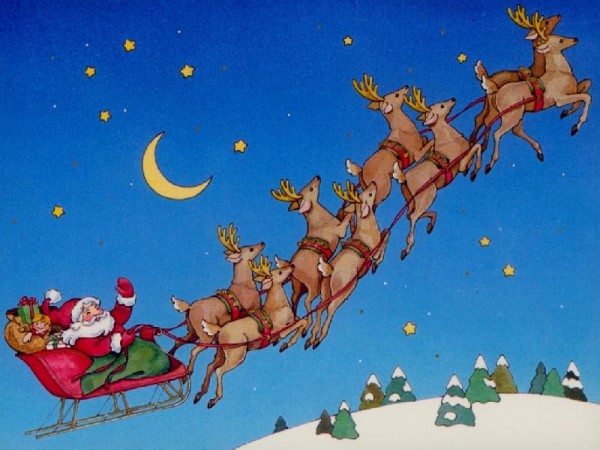
Santa's first problem is that he has a long distance to travel, and not that long to do it. If Santa starts at the beginning of Christmas Eve (after sundown, of course) in places like Australia, Japan, and parts of Russia, and ends in Alaska and Hawaii just before dawn on Christmas morning, it gives him about 36 hours to play with. (Thank you, international date line.)
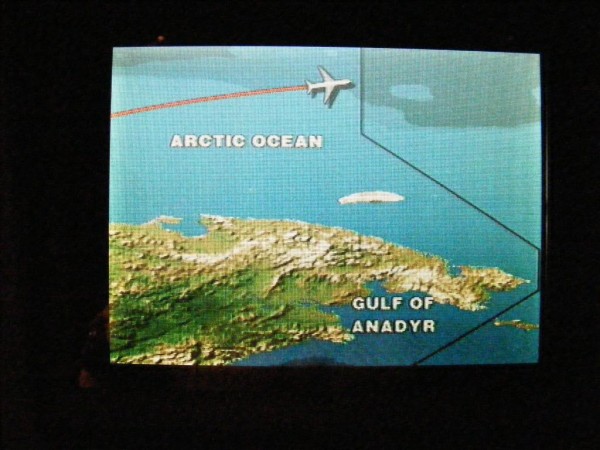
There are nearly 7 billion people in the world; let's round that down and say that Santa has one billion households to visit. Now, in some rural places, it may take many kilometers (or miles) to get to your neighbor's house, and in a metropolis like New York or Tokyo, it may be a matter of mere feet (or meters). Let's split the difference, and assume that each of the one billion households on Earth is 10 meters away from the previous one.
This means that Santa has to travel ten million kilometers in 36 hours. If all he does is travel from house-to-house in this time, he needs to move at an average speed of 77 kilometers per second (48 miles per second). Put another way, he gets about 130 microseconds to travel to, deliver presents to, and leave each household. Perhaps a technology upgrade is necessary?
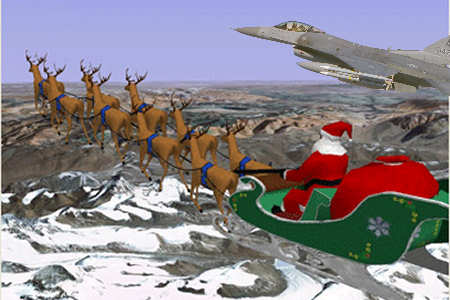
No, an F-16 won't do. In fact, the most powerful rocket we've ever built won't do it, either. There's only one thing that's ever gone as fast through the air as Santa would need to in order to deliver presents: meteors! (Or, as they're better known, shooting stars.) There's... umm... just one problem with meteors.
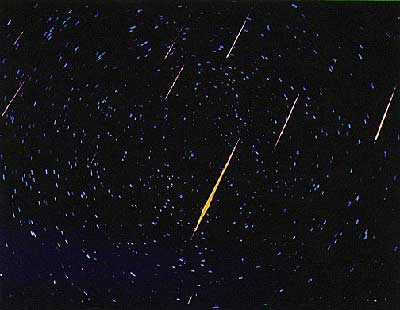
They tend to burn up in the atmosphere! When you calculate how much air resistance affects Santa, you've got to remember that he's directly exposed to the air, in his open sleigh and all.
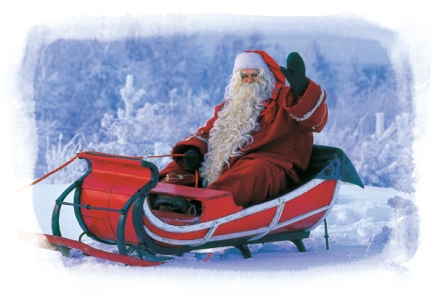
When I work out the numbers for Santa -- moving as fast as he does, exposed to the air -- I find that he needs to dissipate 57 trillion Joules of heat every second to avoid burning up like meteors do. So, there are two reasonable explanations for how he does this.
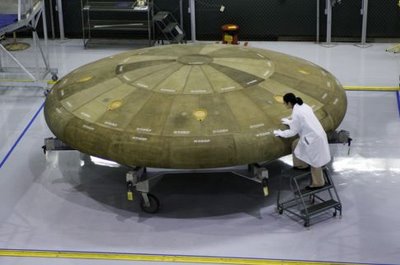
The first explanation is that Santa has the most advanced heat shield ever made. And why wouldn't he; surely his elves are just as good as NASA engineers, yes? But maybe Santa went down the Steve Austin route instead, and was rebuilt better, stronger, and faster than before...
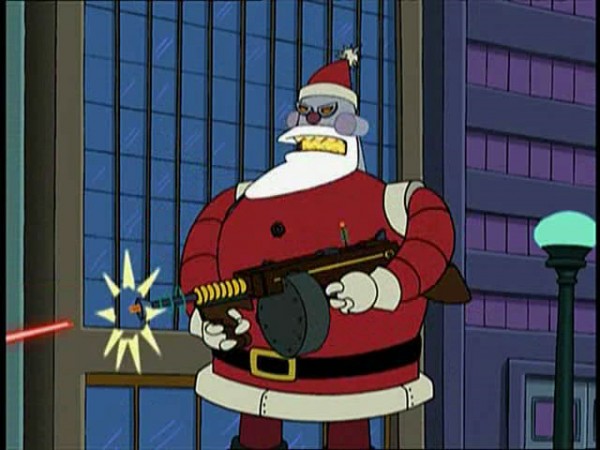
Ladies and gentlemen, Santa could also be a robot! (Or, at the very least, a cyborg.)
Now, forget about chimneys (my house doesn't even have one); in that 130 microseconds, Santa's got to get those presents from his sleigh into my house, and he's got to do it about a billion times. Even if he's a world-class lockpicker (which is, surely, no obstacle for Santa), he still needs to come to rest and speed up again. Going from 77 km/s to rest to 77 km/s again, even if we give him the whole 130 microseconds to do this, means an average acceleration of just over one billion "G"s. If Santa weighs about 100 kg (he's a big guy, after all), this means that just starting and stopping his sleigh makes a force on Santa that's the equivalent of stacking three Empire State Buildings on top of him.
I don't even know how that's possible, except to say that Santa is an unequivocal Christmas badass. However he manages to do it, Santa sure has overcome some tremendous technical obstacles! And yet all over the world, children still manage to receive both love and presents this time of year.
So may peace and joy be with you during this holiday time, no matter how you choose to celebrate it. Me? I'll be dreaming of a visit from the Run DMC Santa...

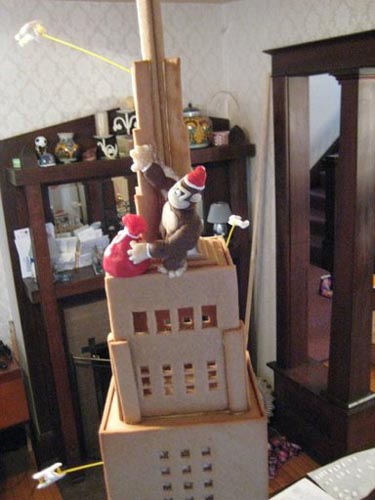
Please. This was all explained in the Hogfather.
But the entire adventure turns out to be so much easier when you figure out there is more than one Santa Claus!
Santa's sleigh is equipped with a Heisenberg Compensator. This allows him to simultaneously deliver toys and not deliver toys to all the good little girls and boys. Santa's toys are like Heisenberg's cat: Until the toys are observed, they exist in a superposition state of both having been delivered and not having been delivered. When a child observes Santa delivering toys, the wavefunction collapses to the no-toys-delivered state, and all you get are the presents, such as underwear, from family. So your calculations need to include all the toys that are not delivered due to wavefunction collapse. Once you account for all the toys not delivered due to the observer effect, I think you'll find that the actual toys delivered falls well within the limits of classical mechanics given the 36-hour timeframe.
Now get to bed!
Santa actually has a device that slows down time FOR HIM ONLY (my father's explanation from my youth) - while leaving it alone for the rest of us. It allows him to take as much time as he needs to deliver presents in his little bubble, with it seemingly being overnight for the rest of us.
Note: my father was born in 1908, and never attended school past the 8th grade. I have no idea where he got this idea (he died in 2002 without telling me or my brothers/sisters), but I do think it was an incredibly clever idea.
With the wonderful advent of the information super highway these days, you don't have to go to school to learn all this stuff. That's how I learned about the Big Bang and how our wonderful universe evolved, because I too dropped out of school.
You forgot to include the mass of all the presents he is carrying (and the great volume of his sled)... although maybe at the speed he is traveling we get some Lorentz contraction.
Santa, like Chuck Norris (http://attuworld.com/wp-content/uploads/2009/12/what_really_happened-1…) has his own dimension.
Happy holidays. Thanks for all the excellent posts.
DaveH.
Happy Holidays to you and yours. Nice post. Almost makes me want to reject the hypothesis that Santa is real. Almost.
Sorry Ethan, I don;t buy a word of that. He's gotta eat the mince pies left out for him, and consume all those drinks. Your figures don't allow for that.
I'm going to be sceptical of anything you say from now on... :0)
The problem is: where does the energy go that is dissipated in the atmosphere? 57 terawatts is equivalent to 14 kT of TNT per second. In 36 hours that would be 1.8 GT.
As population goes up, Santa has to visit more houses (n) but the time he has stays the same. He has to travel faster over a longer path. Since drag goes as v^2, and energy goes as force times length, if the number of houses he visits doubles, he needs to go twice as far at twice the speed, energy dissipated goes as n^3. With such a strong dependence on n, population growth is greatly increasing this dissipation.
As far as I know, no climate model has accounted for this source of energy, and the so called âwar on Christmasâ is only a feeble attempt to reduce it. Is it a coincidence that those who protest against the war on Christmas also tend to be global warming deniers?
The explanation is really very simple, Santa Claus outsources.
Santa doesn't really have all that much work to do; he doesn't even keep a "naughty" list anymore, only a "nice" list - it's very short. The illusion is maintained by all the fakes who give their naughty children presents knowing there's no way in hell their kid's made it onto the "nice" list.
Perhaps he uses a FTL or a Trans Warp Drive on his sleigh
Wait. You mean to tell me there is no Santa Claus? For forty years I have been on my best behavior for what? A misguided sense of goodness in the world? The gloves are coming off this year!
well ! really i am shocked to read full post. i never thought that anyone can prove this much easy. really very very great efforts.
Santa Claus is obviously Chuck Norris, he can round-housekick his sleigh rounding to power alaska for a month. That takes about 4 billion joules, needless to say the horsepower. That amount of force can propel santas slay F=m*A 300 tons * 9.8 m/s2 about 30000 joules.
4000000000/30000= more power than you can imagine
The myth of Santa Claus having but one night to deliver toys is a misunderstanding of the entire lore. If Christmas is a Christian holiday, and indeed it is, we must go back to its origins. Christmas was celebrated from November into the new year. That means Santa Claus has 62 days to deliver presents. Also factor in here that not every culture believes in Santa Claus, so that cuts down the figures quite a bit, and even more so if you go by the Canadian, American and United Kingdom's postal service receiving an estimated 1 million letters every year. That's 3 million there. By my calculations, if theres at least 4 individuals per house hold and it takes Santa Claus 5 minutes to unload the presents, in 62 days he would deliver some one million, seven hundred eighty five thousand, two hundred people----what people also tend to forget is that in the early lore Santa Claus had many helpers, so lets say he has 12 helpers to assist him. With the 12 helpers that number jumps to 21,427,200 individuals. That more than out does the 3 million letters mailed to the US, CAN, and UK postal services. With that, Santa Claus and his 12 helpers would easily be able to give gifts to not only those three countries but to Australia and Europe as well, and STILL have plenty of gifts left over....I bid you farewell and take THAT for trying to disprove Santa Claus!
The Quantum Santa I recently read a paper in which the author tried to disprove the existence of Santa Clause by using the Laws of Newtonian physics. He calculated that Santa would have to visit 7000 houses per second and would have to travel so fast that, not only would Rudolphs nose glow, but the entire reindeer team would burst into flames from aerodynamic friction. The twenty thousand G's of acceleration required would use huge amounts of energy and would likely break all the toys. Then the sonic booms would wake up all the children making the whole trip a total waste of time.
The "Quantum Santa" could have a tendency to exist at everyone's house, all at the same time. He would travel in wave form at near the speed of light and then convert himself into matter as required. The huge amounts of energy required are provided by Einstein's equation which states that " Ethereal Energy equals Merry Christmas squared " On Christmas eve , as the spirit of Christmas increases, the Ethereal Energy available approaches infinity allowing the Quantum Santa to complete his tasks. Any additional energy required could be provided by the milk and cookies consumed along the way. I hope this explanation allows you to relax and enjoy the Holidays knowing that Santa is on his way. By Steve Neef Note that this theory of Ethereal energy can also be used to explain the existence of the Ether Bunny.
Maybe Santa is a technology not yet known. No mention of the possibility of traveling intradimensional. The laws of physics as we know, applies to our universe. Do not "Theory M" are the existence of other dimensions? Is not the other dimensions of being subject to other laws of physics for those who may be in them?
A word of recognition results where criticism and ridicule no. You made an honest and sincere and encouragement to this work. Share it with everyone. Do it! I am sure you like it!
"Santa Claus lives at the North Pole and not much going on aside from the polar explorer from time to time. So you can use all year for self improvement," said Gaute Einevoll.
"Santa Claus lives at the North Pole and not much going on aside from the polar explorer from time to time. So you can use all year for self improvement," said Gaute Einevoll.
The myth of Santa Claus having but one night to deliver toys is a misunderstanding of the entire lore. If Christmas is a Christian holiday, and indeed it is, we must go back to its origins. Christmas was celebrated from November into the new year.
Every Christmas, calculations circulate that have been dubbed "The Physics of Santa Claus". The calculations cast doubt as to whether Santa Claus could possibly deliver gifts to all the world�s nice children � & still stay within the laws of physics. To deliver gifts to all who deserve them, they assert, Santa would require to move so fast that they would vaporise due to air resistance, be torn to pieces by gravitational forces or suffer other terrible fates they wouldn�t wish for Santa Claus.
Ok I've read that many times, and very rude here. No wonder you say that your account has managed to remove many times. It is because of his bad attitude and just to let you know that there are children here.
There are 2 billion children (under 18) in the world. But since Santa does not (appear) to handle Muslim, Hindu, Buddhist and Jewish children, that reduces the workload to 15% of the total - 378 million according to Population Reference Bureau. At an average (census) rate of 3.5 children per household, that's 91.8 million homes. Presumably at least one good child.
Santa has 31 hours of Christmas to work with, thanks to the different time zones and the rotation of the earth, assuming he travels east to west (which seems logical). This works out to 822.6 visits per second. This means that for each Christian household with good children, Santa has 1/1.000 of a second to park the sleigh, jump down the chimney, fill the stockings, distribute the remaining presents under the tree, eat whatever snacks have been left , back up the chimney, back in the sled a pass to the next house. Assuming that each of these 91.8 million stops are evenly distributed around the earth (which, of course, we know that is false, but for the purpose of our calculations to accept the will), we're talking about 0. 78 miles per household, a total trip of 75 "million miles, not counting stops to do what most of us must do at least once every 31 hours, plus feeding, etc.
I'm also going to be sceptical of anything you say from now on....
Stationing at the North Pole allows pre-cooling for his nearly instantaneous acceleration to about the speed of light. At this point time stands still for him and heat as well as energy consumption are no longer a problem since they are both related to time. How much heat can build up or energy be consumed in no time? The concept is easy to grasp and the details are part of the Christmas Magic.
A well thought-out posting.
I knew he couldn't physically do it all.